




Let�s Recall




We see different things around us. Some are big and some are small.



Let’s Warm-up









Tick (✓) the box below the BIG thing.
Mini’s mother baked some cookies.
Mini: Wow, Mummy! These cookies look so different.
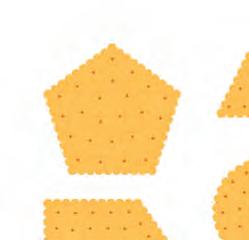
Mummy: Yes Mini! I baked them in different shapes and sizes.



ifferent shapes? Different sizes? What are
Flat Shapes
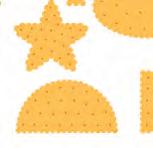
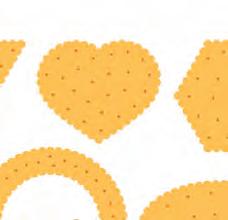



Let us learn about different shapes and sizes.






Here are the cookies of different shapes and sizes.




















Different Shapes











Now let us learn the names of different shapes.












Some cookies are BIG and some are small. They are all of different sizes.



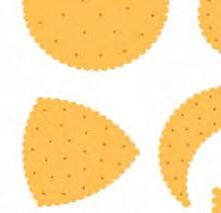



Example 1: Name the flat shape that you see in these things.



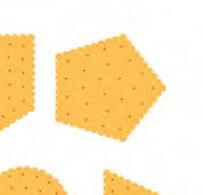








Trace the shapes. Write the name of the shape in the box.
Look at some things that have the same shape.
Example 2: Tick (✓) the box for things that have the shape of a CIRCLE.
Colour all the squares.































1 Heena drew this picture.

a Which shapes did she use to make the tree?
b Which shapes did she use to make the roof?
c Which shape has she NOT used?


Mini goes to a garden. She sees so many trees and plants. There are two paths to walk on.

These paths look different from each other.

Let me tell you how.



Straight lines can be of different types.
Example 3: How many straight lines and curves do you see in these shapes? Join the dots to take the cars to the parking lot.
3 straight lines 2 straight lines, 1 curve

















Write S if the line is straight. Write C if the line is curved. Name the striaght lines as standing, sleeping or slanting. 3
Circle the shapes that are made ONLY with STRAIGHT lines.
Challenge

Critical Thinking
1 Read the letters in the word FUNNY. Write T for True and F for False.
a U is a curve.
b Y has a curved line.
c F has 1 standing line and 2 sleeping lines.

d N has 1 curved line and 2 straight lines.

Milli is playing with her blocks.

Milli: I have blocks in so many shapes. I can see squares and rectangles in some of the blocks and triangles in some.



These are some of the blocks. We can hold them. They have a shape. These are called solid shapes.

Many things around us have the same solid shapes.
Example 4: Cross out () the odd solid shape.
1
2
Colour the solid shape that matches the shape of the object.
Rolling and Sliding
Some solid shapes roll and some slide.
A sphere can roll.
A cube and a cuboid can slide.
A cylinder can both roll and slide. Sliding Rolling

Things around us are solid shapes. We can touch and hold them.
Tick (✓) if the object will roll, slide or both roll and slide. Name the shape of the things.




























Look at the picture. Write the shapes of the things marked.
c
Sam and Sia are playing in the park. They share turns to play on the slide. Then, they put objects on the slide. Tick () the ones that are rolling down.
b Have you seen a matchbox? Does it slide or roll? Challenge

1 Look at the picture. Answer the questions.
a Look at the fallen cone. Will it roll or slide?


Milli’s mother buys a sari.
Milli: Maa, this is pretty.
Maa: Yes, Milli. I really like the pattern on it.
Milli: What is a pattern?
Look at the saree again. Can you see that some repeating shapes on this saree?
We can see red and blue triangles repeating as red, blue, red, blue. Let us look at one more pattern.
Maa: Milli, we see patterns in lots of other things also like: animal skin (cat, zebra), leaves, a beehive, etc.

Patterns are formed with repeated shapes or colours.
Milli: Maa, I got it. Guess what? I can make a pattern using actions like clapping and snapping my fingers.
Example 5: Extend the given pattern. Think and Tell Do you think day and night have a pattern?
Here, the number of triangles is increasing as 1 triangle, 2 triangles, 3 triangles, 4 triangles, 5 triangles and 6 triangles.
We can use thumb prints to create pictures of different animals, birds and flowers.


















a snap, clap, clap, snap, clap, clap, , . b tap, blink, tap, blink, , .
the next shapes to complete the patterns.


Milli knows how to make patterns now. She has some number cards. She is trying to make a pattern with them. See how she places the cards.

The numbers 1 and 2 are repeating. This is a number pattern. Let us see some examples of number patterns.

Example 6: Which is the correct number pattern?
Pattern B is the



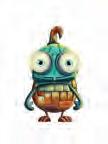

















2
3
4
Do It Yourself 5E

) the set of numbers that form a pattern.
a 4, 5, 4, 4, 4, 5 b 33, 32, 31, 30 c 3, 6, 9, 12, 15
Circle the next number in the pattern.
Fill in the next 2 numbers in the pattern.
a 4 5 6 4 5 6 4 _________ _________
A Seven-Spotted Ladybird Beetle is a beetle that has 7 spots. Look at the pattern. Fill in the blanks.
c 7 spots 14 spots 21 spots
Challenge
1 Sarah created a number pattern with 0 and 1 as 0, 1, 0, 1, 0, 1, 0, 1. Create 2 number patterns with the numbers 2 and 3.


• Circles, squares, rectangles and triangles are flat shapes.
• Things can have the same shape but different sizes.

• Cubes, cuboids, spheres, cones and cylinders are solid shapes.
• Solid shapes can roll or slide. A cylinder can both roll and slide.
• A pattern will have shapes or colours that repeat.

• Patterns in numbers can be seen if we repeat numbers in an order, add or subtract the same number again and again.


Aim: To create patterns with vegetable prints.
Things required: Different vegetables, white drawing paper, string, water colours
Setting: Groups of 5
What to do?


1 Take two vegetables and cut them into slices.
2 Dip the slices in colour and make patterns on the paper.
3 Use these vegetables stamps to make rangoli decorations for your colony or community celebrations. Experiential Learning &
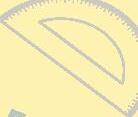

Chapter Checkup
Cross out () the odd shape. 1 a

c Circles d Rectangles 2
Look at the picture. Count and write the number of shapes.
a Squares b Triangles
Colour the pictures with ONLY curved lines.


Match the solid shapes with their correct names.
Help the dog reach the boy. Draw the lines on the path.
Did you draw curved lines or straight lines?









2, 3, 4, 2, 3, 4, , ,
22, 21, 20, , ,
5, 10, 15, , ,
2, 5, 8, 11, , ,
Use thumbprints to create a pattern using two different colours.

Look at the book. Raj puts 4 such books one on top of the other. What solid shape will they make? 1
Maths Value Development & Creativity


Look at the birthday party picture and answer the questions.




1 Name the solid shape of the juice bottle. a cube b cuboid c cylinder d sphere

2 Name the 2-D shape made by the plate. a square b rectangle c triangle d circle

3 Count the number of straight lines in the party hats.

4 Sam distributed sweets to the poor in his neighborhood. Do you help the poor and needy around you? How?



5 Draw a picture to show your own birthday party.


Imagine Mathematics seamlessly bridges the gap between abstract mathematics and real-world relevance, offering engaging narratives, examples and illustrations that inspire young minds to explore the beauty and power of mathematical thinking. Aligned with the NEP 2020, this book is tailored to make mathematics anxiety-free, encouraging learners to envision mathematical concepts rather than memorize them. The ultimate objective is to cultivate in learners a lifelong appreciation for this vital discipline.
• Let’s Recall: Introductory page with a quick recall of concepts learnt in previous grades
• Real Life Connect: Introduction to a new concept related to real-life situations
• Examples: Solved problems showing the correct method and complete solution
• Do It Together: Guided practice for learners with clues and hints to help solve problems
• Think and Tell: Probing questions to stimulate Higher Order Thinking Skills (HOTS)
• Error Alert: A simple tip-off to help avoid misconceptions and common mistakes
• Remember: Key points for easy recollection
• Did You Know? Interesting facts related to the application of concept
• Math Lab: Fun cross-curricular activities
• Challenge: Critical thinking questions to enhance problem-solving and analytical thinking skills
• Real-Life Maths: Scenario-based questions to apply theory to real-life situations
• QR Codes: Digital integration through the app to promote self-learning and practice
Uolo partners with K-12 schools to provide technology-enabled learning programs. We believe that pedagogy and technology must come together to deliver scalable learning experiences that generate measurable outcomes. Uolo is trusted by over 10,000 schools across India, Southeast Asia and the Middle East.

ISBN 978-81-979482-5-1
